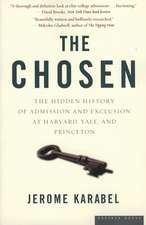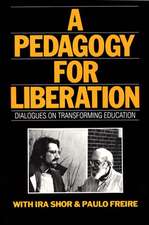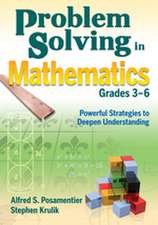Kid’s Eye View of Science: A Conceptual, Integrated Approach to Teaching Science, K–6
Editat de Susan J. Kovalik, Karen D. Olsenen Limba Engleză Paperback – 2 noi 2010
University of Oregon
'This is a book to savor. The content is a woven tapestry: many colorful threads elucidate ideas based in sound research. Marvel at how the authors weave the threads to provide a cohesive, understandable, beautiful educational perspective.'
— Lawrence Lowery, Professor
Graduate School of Education, University of California, Berkeley
A step-by-step approach to taking giant leaps in science learning
Kid's Eye View of Science examines learning science from multiple perspectives—especially a child's. The whimsical character of Mary Froggins guides readers through the steps of igniting students' natural sense of wonder, incorporating brain research, integrating science concepts with other subjects, and applying science to daily life. The authors demonstrate how to teach science conceptually through the lens of "big ideas" such as change, interdependence, and adaptation. Rich with instructional strategies for exploring inquiry-based science, this valuable resource's highlights include:
Charts, graphics, forms, and summaries that help teachers translate abstract concepts into concrete lessons
A comprehensive discussion of brain research, including helpful tips to assimilate 10 bodybrain-compatible elements into the classroom
Practical hands-on guidance for enriching science programs and improving student outcomes
Field-tested and applicable to multiple intelligences, the book also provides a comprehensive vision for curriculum development with an eye toward preparing students to use their knowledge to shape the future.
Preț: 360.15 lei
Nou
Puncte Express: 540
Preț estimativ în valută:
68.91€ • 72.15$ • 57.02£
68.91€ • 72.15$ • 57.02£
Carte tipărită la comandă
Livrare economică 05-19 aprilie
Preluare comenzi: 021 569.72.76
Specificații
ISBN-13: 9781412990912
ISBN-10: 1412990912
Pagini: 312
Dimensiuni: 216 x 279 x 20 mm
Greutate: 0.7 kg
Ediția:1
Editura: SAGE Publications
Colecția Corwin
Locul publicării:Thousand Oaks, United States
ISBN-10: 1412990912
Pagini: 312
Dimensiuni: 216 x 279 x 20 mm
Greutate: 0.7 kg
Ediția:1
Editura: SAGE Publications
Colecția Corwin
Locul publicării:Thousand Oaks, United States
Recenzii
“An excellent guide for integrating new developments in cognitive neuroscience research with an appropriate 21st century elementary science curriculum. Susan Kovalik’s pioneering Integrated Thematic Instruction (ITI) model has continually evolved for 30+ years.”
"This is a book to savor. The content is a woven tapestry; many colorful threads elucidate ideas based in sound research. Marvel at how the authors weave the threads to provide a cohesive, understandable, beautiful educational perspective."
"The authors present a humanistic and highly effective approach to classroom science. This book is a keeper and should be a part of a teacher's professional library."
"This is a book to savor. The content is a woven tapestry; many colorful threads elucidate ideas based in sound research. Marvel at how the authors weave the threads to provide a cohesive, understandable, beautiful educational perspective."
"The authors present a humanistic and highly effective approach to classroom science. This book is a keeper and should be a part of a teacher's professional library."
Cuprins
Welcome From the Authors
Dedication
Preface
Acknowledgments
Introduction
Chapter 1: The Science of Teaching Science
The Quest
Four Principles From Brain Research
Curriculum and the Brain
Bringing Together Being There Locations and State/District Curriculum Standards
Integration Made Easy
Chapter 2: Making Curriculum Bodybrain Compatible
The Challenges
Common Threads
Curriculum Examples
Kindergarten
First Grade
Second Grade
Third Grade
Fourth Grade
Fifth Grade
Sixth Grade
Science Resources
Chapter 3: Localizing Curriculum
Making Curriculum as Conceptual as Possible
Choosing and Using an Organizing Concept
Designing Classroom Curriculum to Fit How the Brain Learns
Key Points: What You Want Students to Understand
Three Kinds of Key Points
Guidelines for Improving Key Points
Examples of Key Points
Chapter 4: Making Learning Memorable
Using Inquiries to Add Action
Guidelines for Writing Inquiries
Examples of Inquiries
Characteristics of Good Inquiries
Chapter 5: The Scientific Thinking Processes
Relating Brain Research With the Scientific Thinking Processes
The Scientific Thinking Processes
Chapter 6: Instructional Leadership
Setting the Groundwork
Preparation
Mindful Selection of Instructional Strategies
The HET Discovery Process
Direct Instruction
Other Strategies
Chapter 7: Age-Appropriate Curriculum
Age Three to First Grade—Comparing the Known to the Unknown
Second to Third Grade—Putting Things Together, Taking Things Apart
Fourth to Sixth Grade—Simultaneous Ideas
Implications
Chapter 8: Assessment
Assessment and the Two-Step Learning Process
A Word About Summative Assessment
Thoughts on Criterion-Referenced Assessment
Built-in Assessment Tools
Basing Formative and Summative Assessment on Inquiries
How to Transform an Inquiry into an Assessment Tool
Science Assessment Resources
Chapter 9: Foundations of Bodybrain-Compatible Learning
Science Versus Intuition and Our Own Experiences
Mounds of Brain Research . . . Four Consistent Themes
Chapter 10: Learning Principle 1—Intelligence as a Function of Experience
Physiological Changes
Enrichment Theory
Lessons to Take Home With You
Chapter 11: Learning Principle 2—The Inseparable Bodybrain Learning Partnership
A Brief History
Emotion—Gatekeeper to Learning and Performance
Movement to Enhance Learning
Chapter 12: Learning Principle 3—Multiple Intelligences
Nature Versus Nurture
The Theory of Multiple Intelligences
Multiple Intelligences in Action
Lessons to Take Home
Chapter 13: Principle 4—Learning Is a Two-Step Process
Step One: Pattern Seeking
Step Two: Developing Programs to Use What We Understand
Lessons to Take Home
Chapter 14: Creating a Bodybrain–Compatible Learning Environment
Ten Elements of a Bodybrain–Compatible Environment
1–Absence of Threat and Nurturing Reflective Thinking
2–Being There Experiences
3–Movement and Aerobic Exercise to Enhance Learning
4–Meaningful Content
5–Enriched Environment
6–Choices
7–Adequate Time
8–Collaboration
9–Immediate Feedback
10–Mastery/Application
Appendix A: Getting the Most Out of Your Being There Study Trips
Preplanning
Training Chaperones
Preparing Your Students
The Day Before the Study Trip
30 Minutes Before the Study Trip
The Bus Trip
Responsibilities On-Site
Teacher Responsibilities After the Study Trip
Appendix B: Lesson Planning Template
Lesson Planning Template
Example of Lesson Planning Template for Fifth Grade
Glossary
List of Figures
About the Authors
Bibliography
Index
Dedication
Preface
Acknowledgments
Introduction
Chapter 1: The Science of Teaching Science
The Quest
Four Principles From Brain Research
Curriculum and the Brain
Bringing Together Being There Locations and State/District Curriculum Standards
Integration Made Easy
Chapter 2: Making Curriculum Bodybrain Compatible
The Challenges
Common Threads
Curriculum Examples
Kindergarten
First Grade
Second Grade
Third Grade
Fourth Grade
Fifth Grade
Sixth Grade
Science Resources
Chapter 3: Localizing Curriculum
Making Curriculum as Conceptual as Possible
Choosing and Using an Organizing Concept
Designing Classroom Curriculum to Fit How the Brain Learns
Key Points: What You Want Students to Understand
Three Kinds of Key Points
Guidelines for Improving Key Points
Examples of Key Points
Chapter 4: Making Learning Memorable
Using Inquiries to Add Action
Guidelines for Writing Inquiries
Examples of Inquiries
Characteristics of Good Inquiries
Chapter 5: The Scientific Thinking Processes
Relating Brain Research With the Scientific Thinking Processes
The Scientific Thinking Processes
Chapter 6: Instructional Leadership
Setting the Groundwork
Preparation
Mindful Selection of Instructional Strategies
The HET Discovery Process
Direct Instruction
Other Strategies
Chapter 7: Age-Appropriate Curriculum
Age Three to First Grade—Comparing the Known to the Unknown
Second to Third Grade—Putting Things Together, Taking Things Apart
Fourth to Sixth Grade—Simultaneous Ideas
Implications
Chapter 8: Assessment
Assessment and the Two-Step Learning Process
A Word About Summative Assessment
Thoughts on Criterion-Referenced Assessment
Built-in Assessment Tools
Basing Formative and Summative Assessment on Inquiries
How to Transform an Inquiry into an Assessment Tool
Science Assessment Resources
Chapter 9: Foundations of Bodybrain-Compatible Learning
Science Versus Intuition and Our Own Experiences
Mounds of Brain Research . . . Four Consistent Themes
Chapter 10: Learning Principle 1—Intelligence as a Function of Experience
Physiological Changes
Enrichment Theory
Lessons to Take Home With You
Chapter 11: Learning Principle 2—The Inseparable Bodybrain Learning Partnership
A Brief History
Emotion—Gatekeeper to Learning and Performance
Movement to Enhance Learning
Chapter 12: Learning Principle 3—Multiple Intelligences
Nature Versus Nurture
The Theory of Multiple Intelligences
Multiple Intelligences in Action
Lessons to Take Home
Chapter 13: Principle 4—Learning Is a Two-Step Process
Step One: Pattern Seeking
Step Two: Developing Programs to Use What We Understand
Lessons to Take Home
Chapter 14: Creating a Bodybrain–Compatible Learning Environment
Ten Elements of a Bodybrain–Compatible Environment
1–Absence of Threat and Nurturing Reflective Thinking
2–Being There Experiences
3–Movement and Aerobic Exercise to Enhance Learning
4–Meaningful Content
5–Enriched Environment
6–Choices
7–Adequate Time
8–Collaboration
9–Immediate Feedback
10–Mastery/Application
Appendix A: Getting the Most Out of Your Being There Study Trips
Preplanning
Training Chaperones
Preparing Your Students
The Day Before the Study Trip
30 Minutes Before the Study Trip
The Bus Trip
Responsibilities On-Site
Teacher Responsibilities After the Study Trip
Appendix B: Lesson Planning Template
Lesson Planning Template
Example of Lesson Planning Template for Fifth Grade
Glossary
List of Figures
About the Authors
Bibliography
Index
Descriere
Rediscover science from a child's perspective and enhance your inquiry-based science toolbox with brain-based strategies that integrate science across content areas and improve student outcomes.












